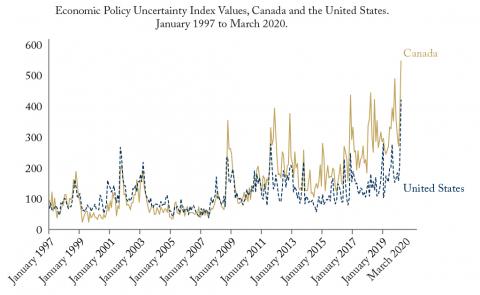From: Scott Baker, Nick Bloom, Steven J. Davis and Stephen J. Terry
To: Canadians concerned about COVID-19’s economic impact
Date: April 22, 2020
Re: COVID-Induced Economic Uncertainty
Major uncertainties surround almost every aspect of the COVID-19 pandemic from the virus itself to the human toll to the economic recovery.
The tremendous speed of the shock makes assessing the macro-economic uncertainty challenging. There are also problems of a lack of recent historic parallels. While the influenza pandemic a century ago offers a reasonable point of comparison in terms of mortality, it took place in a very different social, political and economic context.
To project the potential impact of the pandemic on economic outcomes, we need forward-looking uncertainty measures that are available in real time, or nearly so. No matter how good the model linking uncertainty to GDP growth, for example, we can’t expect the model to give useful answers without sensible inputs. Thus, we need timely, forward-looking measures.
Consider five measures of uncertainty and how they stack up:
Stock Market Volatility: The VIX, which reflects the forward-looking volatility implied by options on the S&P 500 index, rose by about 500 percent from mid-January to the end of March. This forward-looking measure starts in 1990 and is available daily in real time.
Newspaper-Based Measures: Examples include the Economic Policy Uncertainty (EPU) indices available here. These indices reflect the frequency of articles with one or more terms about “economics,” “policy” and “uncertainty” in leading national newspapers. The figure below displays monthly indices for Canada and the United States. Each index is normalized to 100 from 1985 to 2010, so values above 100 reflect higher-than-average uncertainty. Each country experienced extremely large EPU jumps from February to March. Canada’s index stands at 553 in March 2020, the highest in the history of the series back to 1985. The US index stands at 427, also the highest ever.
Newspaper-based measures of uncertainty are forward looking in that they reflect the real-time uncertainty perceived and expressed by journalists. They also offer a ready ability to drill down into the sources of economic uncertainty and its movements over time, as contemporaneously perceived. More than 90 percent of newspaper articles about economic policy uncertainty in March mention some pandemic related term.
Business Expectation Surveys: These surveys elicit forecast distributions over each firm’s own future sales growth rates at a one-year look-ahead horizon. By calculating each firm’s subjective standard deviation about its own future growth rate forecast in a given month, and aggregating over firms in that month, we obtain an aggregate measure of subjective uncertainty about future sales growth rates (see the early March US and UK data). Developing a similar survey for Canada would give policymakers and business leaders a useful new source of information about the economic outlook.
Forecaster Disagreement: Examples include the dispersion of point forecasts about macroeconomic outcomes among participants in the Survey of Professional Forecasters (SPF). The typical disagreement measure is the standard deviation of point forecasts across the 50 odd forecasters that provide regular forecasts. There is a long history of using such disagreement measures to proxy for uncertainty (and a long history of disagreement about their suitability for that purpose). For our present purpose, there is a practical issue: The most recent SPF data are from mid-February, the COVID spread beyond China, and its quarterly frequency results in a data lag too long for periods of rapid change.
Statistical Forecast Uncertainty: Examples include models that predict uncertainty from past volatility or the forecast uncertainty implied by a large statistical model, as in prominent research by Kyle Jurado, Sydney Ludvigson and Serena Ng. These approaches can be used to generate time-varying measures of forecast uncertainty for GDP growth, industrial production, employment, trade, and other standard measures. They capture recurring relationships in the data – for example, the strong propensity for the volatility of many economic measures to rise in recessions – but their backward-looking character makes them less useful in the wake of abrupt shifts and once-in-a-century shocks. Long lags in the availability of key data inputs into statistical models of this type, 60 days or so, are another serious limitation for real-time uncertainty measurement, especially in the wake of sudden and unusual shocks.
To summarize: The COVID-19 pandemic created an enormous uncertainty shock – larger than the financial crisis of 2008-09 and more similar in magnitude to the rise in uncertainty during the Great Depression of 1929-1933. We need real-time, forward-looking uncertainty measures to project the full impact of the pandemic on the economy. Some of our recent research illustrates how to make such projections. Using stock-market measures as inputs, we project that the COVID-19 shock will cause US real GDP to contract 11 percent in the fourth quarter of 2020 on a year-on-year basis.
Scott Baker is associate professor of finance at the Kellogg School of Management, Nick Bloom is professor of economics at Stanford University, Steven J. Davis is professor of economics at Chicago Booth and senior fellow at the Hoover Institution, and Stephen J. Terry is assistant professor of economics at Boston University.
To send a comment or leave feedback, email us at blog@cdhowe.org.
The views expressed here are those of the authors. The C.D. Howe Institute does not take corporate positions on policy matters.






